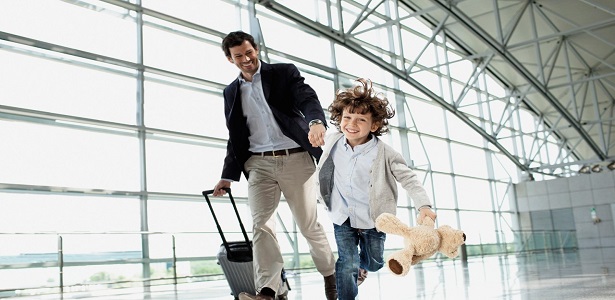The problems began when we boarded the plane and realized we had been seated in a different part than our children, and due to the adults sitting in an exit row, I was unable to sit near my son with autism spectrum disorder (ASD).
Things went from bad to worse throughout the flight. Bad turbulence meant no one could leave their seats for five hours, and the food and drink service was suspended during this time. The flight attendant had promised my son a drink but never came back. When he was eventually attended to after five hours, he was told they had run out of the drink he wanted, despite it having been served to the row behind.
At one point, my child was made to move by the flight attendant without warning or the ability to pause his movie first. He got more and more stressed, and to cut a long story short, by the time we landed seven hours later (and his movie abruptly turned off again), he was in full-on head banging, punching, kicking, and loudly-screaming meltdown mode! I couldn’t calm him down until we were off the plane, through security, and in a quiet corner of the baggage reclaim room.
Now, all children with autism are different, and all flights and airlines are different. The above story, as any parent of a child with ASD would understand, is by far our worst flying experience.
Travelling by plane with children is difficult. Travelling by plane with a child with ASD can be extra challenging. Airports and planes can be extremely stressful, anxiety-provoking, and overstimulating places for children on the spectrum. You can, however, make it as easy as possible to fly with a little bit of hard work and forward planning.
My 11-year-old son with ASD has been on over 50 planes and has survived them all! Here are my top 10 tips for travelling by plane with a child living with autism:
- Book seats in advance: Phone the airline you are travelling with or the travel agent you booked the flight through and ask for allocated medical seats so your family can be seated together. If your child is likely to kick, ask for bulkhead seats so as not to annoy other passengers. Most airlines are very helpful with this but some do not include ASD as a reason for medical seats. In this instance, it is better to pay to book seats in advance.
- Call or email the airports you are traveling from, through, and to: Some airports have great autism schemes. Manchester Airport in England, for example, will send you a terminal-specific booklet in advance for your child to learn about the airport and what will happen during the flight. There is also an activity book to do while your child goes through the airport, reduced-price parking in the closest car park to the terminal, and most helpful of all, a blue wristband. This wristband enables all airport workers to see that you are travelling with a passenger who has autism. You get to pass through security lines quickly, and you will receive extra patience going through security and help when you need it. Many airports will go out of their way to help you and arrange anything—they’ll locate your bags, allow you to skip lines, escort you between flights to free stays in airport lounges, and put you on earlier flights. Most airports will be helpful and will email you pictures so you can prepare your child, and some have social stories available for this purpose.
- Contact TSA in advance: If you are travelling to, within, or from the USA, then contact Transportation Security Administration (TSA) a few weeks before you travel. They have been so helpful to us over the years. TSA also has a downloadable card you can print and show at security points. Depending on the airport, there are different ways they can help, but it generally involves being met off the plane or calling a number when you get there and then being escorted through security, passport control, and more, which avoids lines and makes the whole process easier.
- Visit an airport preview: If your child has never been on a plane and is feeling anxious, there are also some airports that offer times for you to take your child and get on a plane for practice or for a tour. Alternatively, just visiting or going to a viewing park may help prepare your child. If you are unable to visit, then try to get some pictures or social stories to help your child know what to expect.
- Park as close as you can: We always drive to the airport and pre-book an onsite parking lot, preferably one close enough to walk to the terminal. This cuts out the added stress of taxis and buses.
- Skip the queues: Once in the terminal, it is worth talking to a member of the staff near the check-in line, as they can normally send you down to a disabled or priority passenger line to check in, which is less stressful. If you are at an airport like Manchester with the wristband, then you can fast track through security using the special assistance line. Otherwise, make use of the disabled line and just explain to the person manning the entrance.
- Book a lounge or hotel: If you can afford it, book an airport lounge. It is cheaper to book online in advance. You may just need this amazing oasis in the middle of a chaotic airport to help calm your child before or between flights. They are quiet, with free food and drink, Wi-Fi, comfy chairs, and close-by bathrooms. If you have a very long wait between connecting flights, it is worth looking into booking a hotel room. Some hotels are actually attached to the airport, and depending on the time needed, you can book a room for a night or just for a day.
- Board the plane first or last: Ask for priority boarding. Speak to the staff when you check in or drop your bags off at the airport, or even the staff at the gate where you board. At least one of these places will help you, and you will be able to board the plane first. This way, you can settle your child on an empty plane before crowds of people pack into the aisles. If you are late for some reason, then board last, when everyone else is seated!
- Preparing for takeoff: In terms of keeping your child calm on the flight, you know him/her best. If your child won’t sit next to a stranger or would be irritated about having to continually get up, then maybe consider the window seat. If you know your child would be better getting up to walk around or would frequently need to use the lavatory, then consider an aisle seat. Take comfort items and anything you may need on board with you. For instance, we take a ‘taggy’ blanket, a favorite soft toy, an iPad, stretchy elastic, and ear defenders. We make sure to get a drink and food at the airport to take on the plane, too. Talk to the cabin staff, since they are normally very understanding and will make allowances for your child, such as leaving head phones or ear defenders on for take-off and landing. Always sit next to your child, and be prepared to spend the whole flight keeping him/her calm! I take little cards with me I’ve printed myself which simply state: “My child has autism and sensory processing difficulties. He does not mean to be rude but may not answer when spoken to. He doesn’t deal well with queues or crowds of people. He is not being naughty but sometimes everything gets too much! Thank you for your patience.” I only use these if needed, as generally most people are incredibly understanding.
- Look after yourself: Make sure you get plenty of sleep the night before, make sure you have eaten prior to the flight, and try to be as prepared as you can. Obviously, sometimes things can be out of your control. You may not get to rest on the flight and it can be hard work, but it is a necessary part of traveling. After all, missing out on the many adventures you can have would be such a shame.

